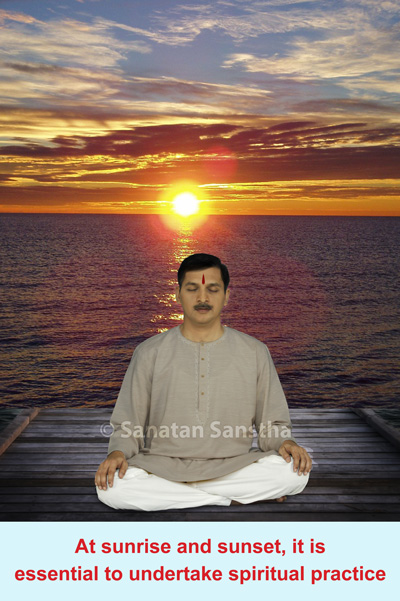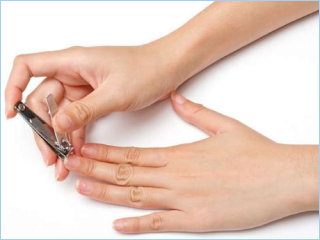1. Since at sunrise the percentage of Raja-Tama-predominant particles
in the atmosphere is more than in the sunrays, avoid contact with sunrays
आरोहणं गवां पृष्ठे प्रेतधूमं सरित्तटम् ।
बालातपं दिवास्वापं त्यजेद्दीर्घं जिजीविषुः ।। -Skand-Puran, Brahmakhand, Dharmarnyamahatmya, 6.66-67
Meaning : One who desires to live long should not climb the back of a cow or a bull, should not allow the smoke from a funeral pyre to touch his body, should not sit on the bank of a river (other than the Ganga) at dusk, should not allow the rays of the rising sun to touch his body and should not sleep during the day.
Underlying science of avoiding contact with rays of the rising sun
‘The rays of the rising sun begin the process of disintegration of the Raja-Tama-predominant particles, which have accumulated in the environment at night. This friction generates lot of heat in the environment. In addition, since the proportion of Raja-Tama-predominant particles in the environment during sunrise is more than in sunrays, these particles gain some amount of momentum along with the sunrays. Hence, we should avoid contact with these sunrays. As the Tejtattva (Absolute Fire Principle) in the rays grows, the concentration of Raja-Tama-predominant waves in the environment falls markedly thus purifying the environment.’ – A Scholar (Through the medium of H.H. (Mrs.) Anjali Gadgil, 21st March 2005, 1.56 p.m.)
Ms. Yuvaradni Shinde (Sanatan’s lady-seeker)
Here you say that you should avoid contact with the rays of the rising sun. While during worship of the rising sun, it is said that rays of the rising sun should touch the body; some even recommend viewing them. How will you justify the conflicting statements?
A Scholar
To achieve control over the Tej-tattva, Shakti worshippers undertake spiritual practice by performing Traṭak (Staring at the sun) or penance by causing pain to the body by exposing it to the sunrays. However, for those following Sahajyoga (State of self-realisation produced by kundalini (Dormant spiritual energy in the subtle-body) awakening), this is not necessary.
Worship at sunrise means undertaking maximum chanting during that period without coming into direct contact of the sunrays.’
(Through the medium of H.H. (Mrs.) Anjali Gadgil, 22nd March 2005, 7.32 p.m.)
Intensity of the Raja-Tama-predominant waves
being high during the transition period at sunrise and
sunset, it is essential to undertake spiritual practice at that time

‘Raja-Tama-predominant waves start decreasing in the transition period during sunrise and start increasing in the transition period during sunset. These two being the main periods of concentration of Raja-Tama-predominant waves, to avoid adverse effects the individual is advised to undertake spiritual practice at sunrise and sunset to enhance its sattvikta. Once the sattvikwaves in the individual increase, they create a protective sheath around the individual, reducing the ill-effects of sunrise and sunset.’ – A Scholar (Through the medium of H.H. (Mrs.) Anjali Gadgil, 22nd March 2005, 6.19 p.m.)
Sleeping at sunrise makes us susceptible to acquiring of Patal (Hell region)
‘After sunrise, sattvik waves reach the earth. During this period, Deities in the form of fragrance descend onto the earth. At this time if an individual sleeps instead of performing spiritual practice, then the physical body gets charged with distressing vibrations from Patal. These Raja-Tama-predominant waves are then emitted to the atmosphere, blocking the entry of sattvikwaves onto the earth. Hence, such an individual may have to face the wrath of inferior Deities. That is why, it is said that the individual becomes susceptible to committing a sin that is, acquiring of Patal.’ – A Scholar (Through the medium of H.H. (Mrs.) Anjali Gadgil, 2ndJune 2007, 12.06 p.m.)
Continuing sleeping at sunrise results in a sin
because of not availing the benefit of the sattvikwaves
‘Sleeping during sunrise deprives us from chanting and benefitting from the sattvikwaves, thus making us a slave to sleep. It is therefore considered to be a sin.’ – A Scholar (Through the medium of H.H. (Mrs.) Anjali Gadgil, 22nd February 2005, 7.22 p.m.)

 Nine benefits of waking up at the Brahmamuhurt
Nine benefits of waking up at the Brahmamuhurt How to plan your day effectively?
How to plan your day effectively? Astrological viewpoint : On which days should nails be cut?
Astrological viewpoint : On which days should nails be cut? Varsha Rutucharya – a key to remaining healthy during the rainy season
Varsha Rutucharya – a key to remaining healthy during the rainy season Actions required to be performed after cleansing the teeth
Actions required to be performed after cleansing the teeth Cleansing the teeth
Cleansing the teeth